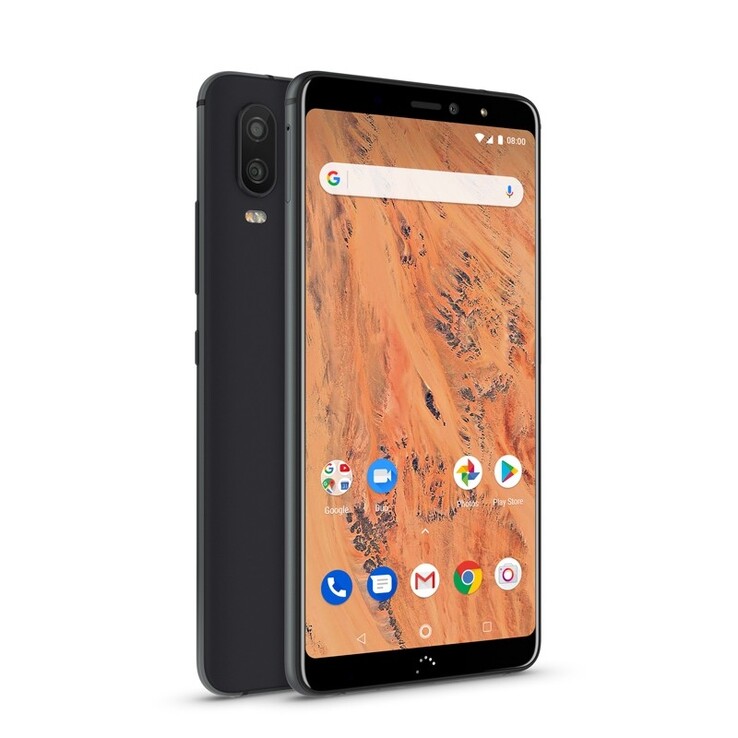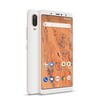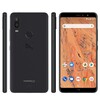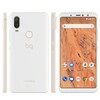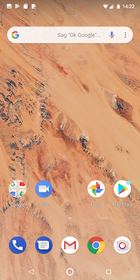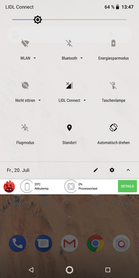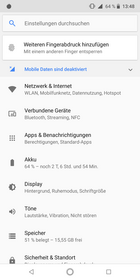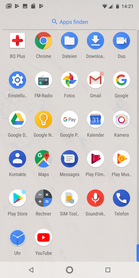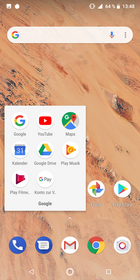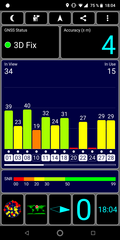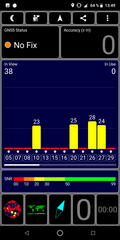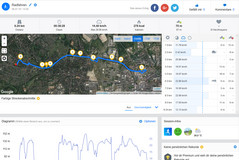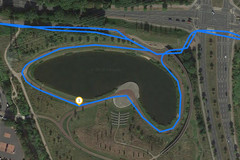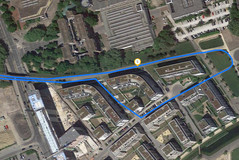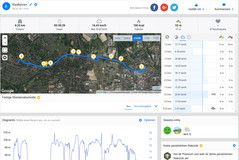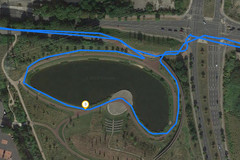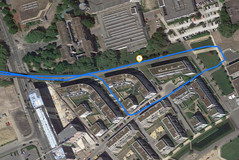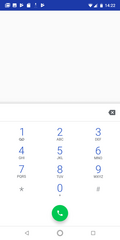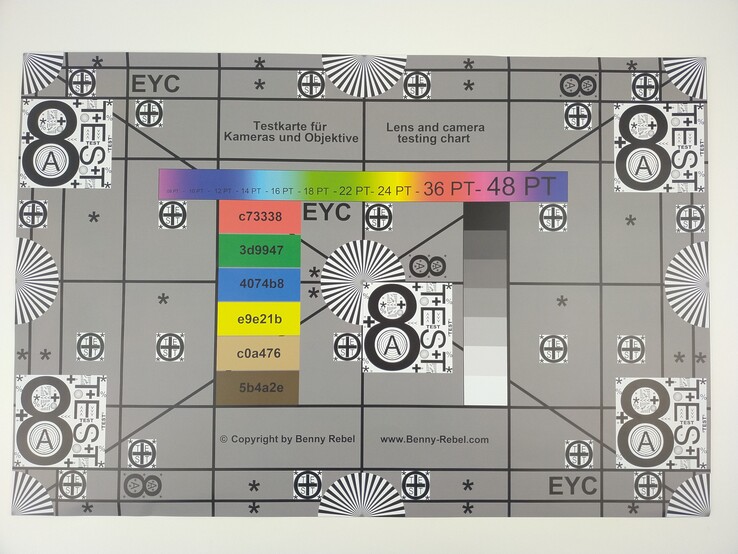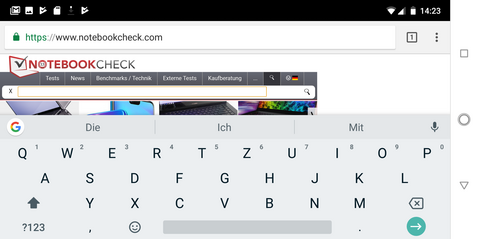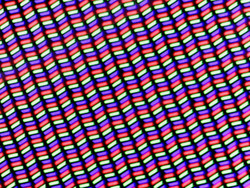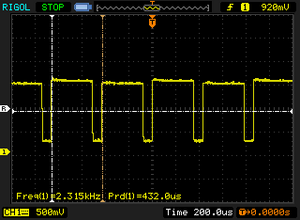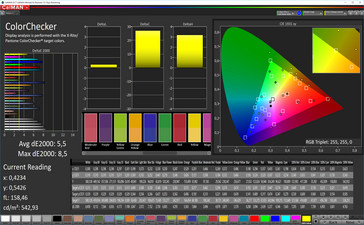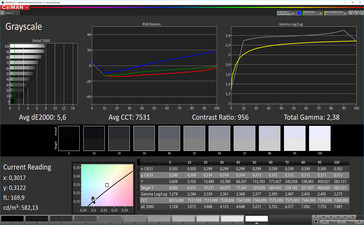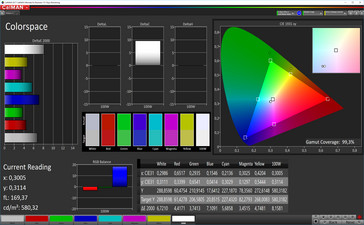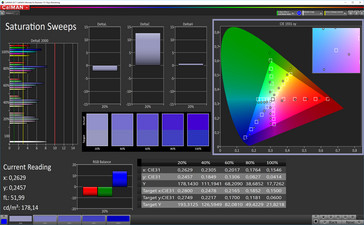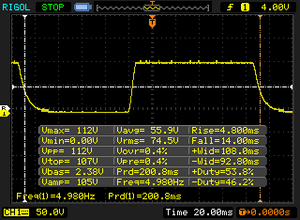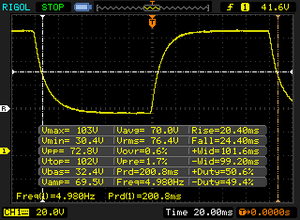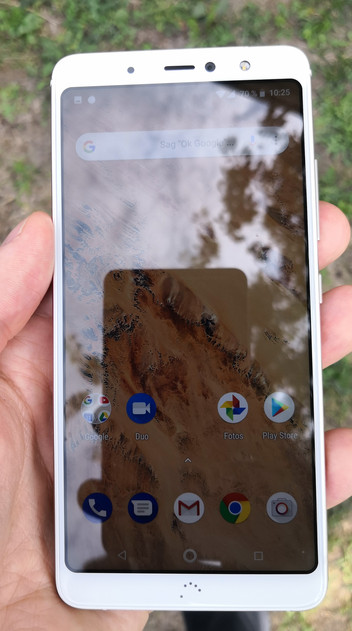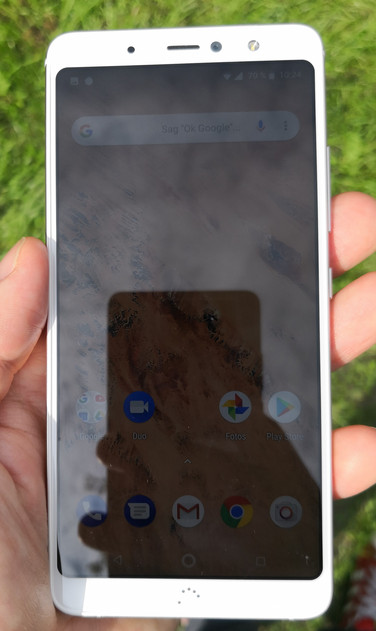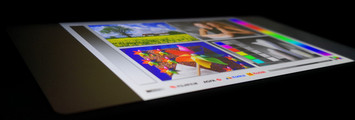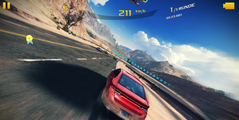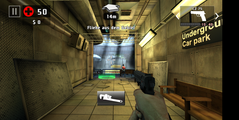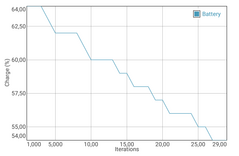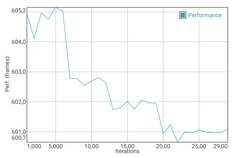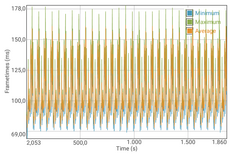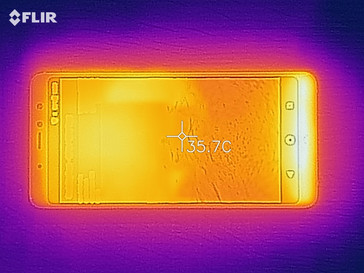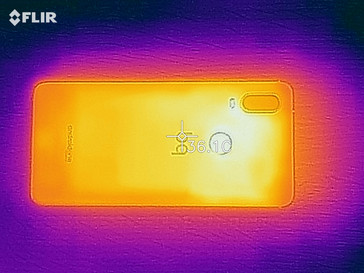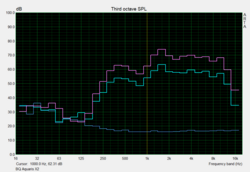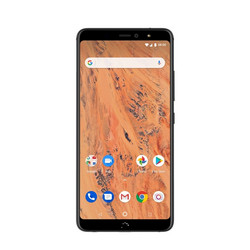BQ Aquaris X2 Smartphone Review
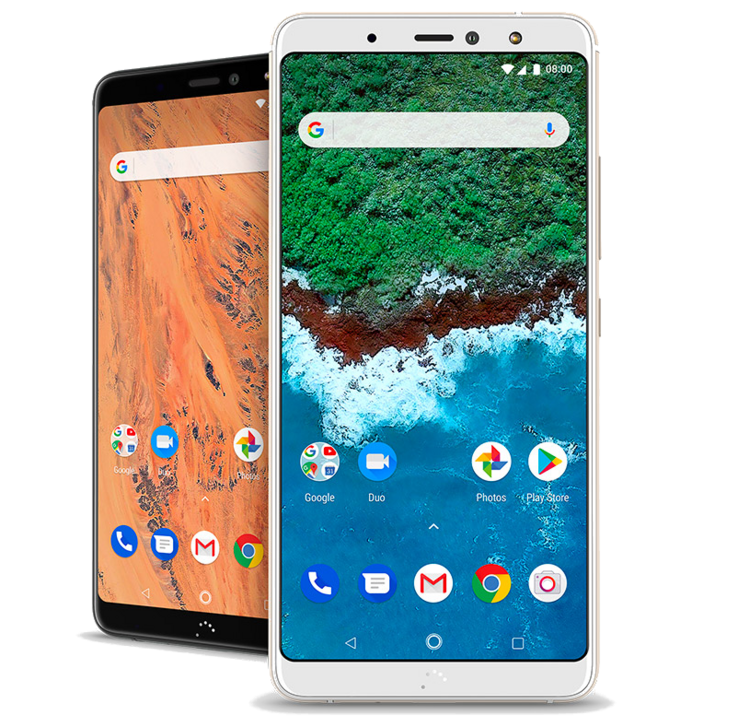
The successor of the popular mid-range model Aquaris X, produced by the European manufacturer BQ, whose headquarters are in Madrid, Spain, was presented at the beginning of this year and has been available for purchase for a few weeks now. In exchange for 320 Euros (~$372), you will receive an FHD+ 5.65-inch display in the 18:9 format, 3 GB of RAM and a Qualcomm Snapdragon 636 SoC.
Please note: This device is not widely available in the US at the time of writing. It can be purchased from the BQ website with an additional delivery fee of 65 Euros (~$80).
Unlike last year's model, BQ has now decided to join the Android One program, which includes the camera recognition software Google Lens. This makes the Aquaris X2 one of the first smartphones that incorporates Google Lens into its camera app. Google Lens uses an AI-based recognition system to give you information about any items that you point your camera at.
There is another version of the Aquaris X2 (the Aquaris X2 Pro) that offers 64 GB of storage and 4 GB of RAM for about 390 Euros (~$460). We were given the smaller version for testing, which has the configuration mentioned above.
Competition is high in this mid-range price segment between $350 and $450, which is why our list of comparison devices is rather long. We have included the Motorola Moto G6 Plus, the Nokia 6, the Xiaomi Redmi Note 5, the Samsung Galaxy A6 (2018) and the Honor 7X. The Nokia 7 Plus, which is only slightly above our test unit's price range, also has Android One and a more powerful Qualcomm Snapdragon 660 SoC. The latter is also used in the Xiaomi Mi 6X imported from China and recently tested on Notebookcheck. The Xiaomi smartphone, however, only costs about $300. In Europe, this phone is marketed as the Xiaomi Mi A2 and also includes Android One.
Case
The case of the Aquaris X2 has a glass surface over the display, a metal frame and a plastic back, which can come in the colors "Sand Gold" or "Carbon Black". The back is slightly curved and cannot be removed. Our Sand Gold version is matte and gives way slightly under pressure, which is not a good sign for quality. At least the case has an IP52 certification, which means it is protected against dust and water drops (maximum amount of water: 3-5 mm³/min for a maximum of 10 minutes). The battery cannot be removed by the user. The metal frame gives the smartphone decent stability but contributes to its weight of 163 grams. The phone is nice to handle as it is only 8 mm thick and 151 x 72 mm large. The volume control and power buttons are positioned on the right side of the case and are easy to reach. They also have a comfortable pressure point and sit nice and tight. The sides and areas at the top and bottom of the Aquaris X2's Infinity display have turned out rather large. The display-to-surface ratio is therefore only 76%. Compared to the 70% of its predecessor, the Aquaris X, this is still an improvement.
Connectivity
The BQ Aquaris X2 features a fingerprint reader, Wi-Fi calling, a compass and a configurable status LED. The wireless transfer of display content to an external display is also supported with Miracast.
Our test unit's internal eMMC storage device has a capacity of 32 GB, although users only have about 21 GB available ex-works. It is possible to expand the dual-SIM smartphone's storage to up to 256 GB by placing a microSD card into one of the two SIM slots. However, the card cannot be recognized as internal storage.
The 3100-mAh battery can be recharged via the USB Type-C 3.1 port positioned on the bottom of the device. You can also connect peripheral devices such as external keyboards or USB sticks with the USB port via an OTG adapter. Headphones can be plugged into the 3.5-mm audio jack.
Software - fast updates thanks to Android One
BQ has decided to use Google's Android One for its Aquaris X2, which also means that the device has pure Android. The Android One program does not allow the manufacturer to make changes to the software or add their own user interface. This speeds up the distribution of updates and security patches for the various phones. The Aquaris X2 on Android will therefore receive the newest software updates for two years and security patches for three years. The BQ smartphone is shipped with Android 8.1.0 Oreo. The only additional app that is preinstalled on the phone is the BQ Plus app. It also has an Ambient Display and double-tap-to-wake functionality to turn on the screen.
Communication and GPS
Wireless communication is enabled by Bluetooth 5.0 and a near-field-communication chip (NFC). The integrated Wi-Fi module supports IEEE 802.11 ac/b/g/n (dual-band) and both the 2.4 and 5 GHz bands. The range and attenuation at close proximity to the router (Telekom Speedport, W921V) are good at -38 dBM.
The Qualcomm X12 LTE modem in the Aquaris X2 supports download rates of up to 300 Mb/s and 50 Mb/s upload in LTE networks. Our test unit is a dual-SIM phone, which means that you can use up to two nano-SIM cards simultaneously. The hybrid slot does not have any limitations in terms of LTE frequencies. The smartphone's reception is good in the German D2 Vodafone network.
The Wi-Fi transfer rates between the smartphone and our reference router Linksys EA 8500 are impressive. The data transfer rates remain at around 300 Mb/s throughout the test; this is a good result for this price range.
Mobile localization is taken care of by the satellite systems GPS, GALILEO and GLONASS. Positioning works best outdoors, where the phone found our location quickly and within four meters. It is also possible to get a signal indoors, but this is not strong enough to locate us. In addition, we tested the phone's localization capabilities by taking it on a 9-km bike ride together with the professional navigation system Garmin Edge 500. There was a difference of only 10 meters between the two systems at the end of the ride. This is a good result and the device should be usable for navigating in the car or on a bike.
Telephone & Call Quality
The telephone app in our test unit is the standard Android application. It offers fast access to your contacts and favorites. The call quality of the BQ smartphone is very good and both sides can understand the other very well during our test call. The speakers and microphones also make video calls very comfortable when there is not too much background noise. The Aquaris X2 supports modern standards such as VoLTE (this is supposed to be added in a later update according to BQ) and Wi-Fi calling.
Cameras - a dual camera setup for the BQ phone
The dual camera system in the Aquaris X2 consists of a Samsung S5K2L8 sensor with 12 MP and a Samsung S5K5E8 sensor with 5 MP. The 12-MP CMOS sensor on the main camera (on the back of the device) has a pixel size of 1.29 μm, so photos should be very bright. Videos are recorded with the video stabilizer "Vidhance" at up to 4K and 30fps.
The camera quality is good for a mid-range smartphone and the shutter speed for autofocus with phase detection is quite fast. The photos show a lot of details and are sufficiently sharp. Colors appear natural but tend to be a little pale and sometimes have a slight red cast.
We noticed a big improvement compared to the predecessor when taking low-light pictures. The aperture of f/1.8 enables the Aquaris X2 to take brighter pictures that are of decent quality if there is sufficient ambient light. But still, taking photos in dark surroundings remains the largest weakness of the BQ Aquaris X2. The camera often has difficulties focusing properly in the dark and takes photos with ragged edges and image noise.
The front camera has 8 MP, an aperture of f/2.0 and a flash. The Samsung S5K4H7 sensor records videos at 1080p and 30 fps and takes very good photos, although image sharpness does suffer a little from the fixed focus.
The BQ camera app was adapted for Google Lens and functions such as Play Photos, time lapse, filters and 10x zoom. Screenshots are no longer displayed within the camera app.
Accessories and Warranty
Apart from the smartphone itself, the box of our test unit contained a user's manual, a USB cable plus a modular 18-W power supply (9V, 2A).
The phone has a warranty of 24 months. You can additionally insure the device against theft or other issues for another 50 Euros (~$60). Please see our Guarantees, Return policies and Warranties FAQ for country-specific information.
Input Devices & Handling
The smartphone is operated via three on-screen buttons in the bottom third of the display. The 5.65-inch display responds precisely to inputs even in the corners. As expected, the device uses the standard Google keyboard Gboard.
The fingerprint reader on the back unlocks the BQ smartphone quite quickly. It also does not take very long for the display to turn on from being in standby.
Display - bright 2:1 IPS panel
Like its predecessor, the Aquaris X2 is equipped with an IPS LTPS LC display with Full HD resolution. Now, however, it has a 2:1 format and a diagonal of 5.65-inches. This means that the pixel density is around 427 ppi. Content looks very crisp.
The display is very bright at over 600 cd/m² and has an even brightness distribution of 96%. When the ambient light sensor is turned on, the Aquaris X2 cannot reach its full luminosity (576 cd/m²). During our realistic APL50 measurement, which simulates an even distribution of bright and dark areas on the IPS screen, the display reached a brightness of 635 cd/m².
The screen has PWM flickering at a frequency of 2315 Hz at lower brightness levels up to 38%. This would not have been necessary considering the display technology used.
| |||||||||||||||||||||||||
Brightness Distribution: 96 %
Center on Battery: 631 cd/m²
Contrast: 1034:1 (Black: 0.61 cd/m²)
ΔE ColorChecker Calman: 5.5 | ∀{0.5-29.43 Ø4.78}
ΔE Greyscale Calman: 5.6 | ∀{0.09-98 Ø5}
99.3% sRGB (Calman 2D)
Gamma: 2.38
CCT: 7531 K
| BQ Aquaris X2 IPS LCD, 2160x1080, 5.7" | Motorola Moto G6 Plus IPS, 2160x1080, 5.9" | Nokia 6 2018 IPS, 1920x1080, 5.5" | Nokia 7 Plus IPS, 2160x1080, 6" | Xiaomi Mi 6X LCD IPS, 2160x1080, 6" | Xiaomi Redmi Note 5 IPS, 2160x1080, 6" | Huawei Honor 7X IPS, 2160x1080, 5.9" | Samsung Galaxy A6 2018 Super AMOLED, 1480x720, 5.6" | HTC U12 Plus Super LCD 6, 2880x1440, 6" | |
|---|---|---|---|---|---|---|---|---|---|
| Screen | 24% | -22% | 21% | -13% | 13% | 19% | 10% | 22% | |
| Brightness middle (cd/m²) | 631 | 761 21% | 417 -34% | 458 -27% | 459 -27% | 518 -18% | 533.2 -15% | 453 -28% | 395 -37% |
| Brightness (cd/m²) | 622 | 723 16% | 421 -32% | 463 -26% | 441 -29% | 532 -14% | 511 -18% | 459 -26% | 402 -35% |
| Brightness Distribution (%) | 96 | 90 -6% | 88 -8% | 92 -4% | 91 -5% | 94 -2% | 88 -8% | 93 -3% | 90 -6% |
| Black Level * (cd/m²) | 0.61 | 0.69 -13% | 0.61 -0% | 0.22 64% | 0.47 23% | 0.23 62% | 0.35 43% | 0.37 39% | |
| Contrast (:1) | 1034 | 1103 7% | 684 -34% | 2082 101% | 977 -6% | 2252 118% | 1523 47% | 1068 3% | |
| Colorchecker dE 2000 * | 5.5 | 2.4 56% | 6.1 -11% | 4 27% | 5.8 -5% | 5.66 -3% | 2.83 49% | 2.6 53% | 1.6 71% |
| Colorchecker dE 2000 max. * | 8.5 | 5.2 39% | 11.2 -32% | 7.4 13% | 10.7 -26% | 10.32 -21% | 6.72 21% | 9.2 -8% | 3.4 60% |
| Greyscale dE 2000 * | 5.6 | 1.8 68% | 7.1 -27% | 4.7 16% | 7.3 -30% | 6.8 -21% | 3.7 34% | 1.6 71% | 1.1 80% |
| Gamma | 2.38 92% | 2.21 100% | 2.16 102% | 2.19 100% | 2.28 96% | 2.269 97% | 1.9 116% | 2.07 106% | 2.14 103% |
| CCT | 7531 86% | 6312 103% | 8362 78% | 7425 88% | 7984 81% | 8564 76% | 6918 94% | 6356 102% | 6536 99% |
* ... smaller is better
Screen Flickering / PWM (Pulse-Width Modulation)
| Screen flickering / PWM detected | 2315 Hz | ≤ 38 % brightness setting | |
The display backlight flickers at 2315 Hz (worst case, e.g., utilizing PWM) Flickering detected at a brightness setting of 38 % and below. There should be no flickering or PWM above this brightness setting. The frequency of 2315 Hz is quite high, so most users sensitive to PWM should not notice any flickering. In comparison: 53 % of all tested devices do not use PWM to dim the display. If PWM was detected, an average of 8091 (minimum: 5 - maximum: 343500) Hz was measured. | |||
The combination of great brightness with a black value of 0.61 cd/m² means that our display has a good contrast ratio of about 1000:1. Our APL 50 measurements showed a similar contrast ratio (1043:1) as the black value remains constant at evenly distributed light and dark areas.
The display analysis with the help of our spectrophotometer and the CalMAN software shows a relatively high color deviation for this price range at 5.5 for colors and 5.6 for grayscales. The color temperature of the display is rather cool at 7500 Kelvin. This results in a slight blue cast.
Display Response Times
| ↔ Response Time Black to White | ||
|---|---|---|
| 18.8 ms ... rise ↗ and fall ↘ combined | ↗ 4.8 ms rise | |
| ↘ 14 ms fall | ||
| The screen shows good response rates in our tests, but may be too slow for competitive gamers. In comparison, all tested devices range from 0.1 (minimum) to 240 (maximum) ms. » 40 % of all devices are better. This means that the measured response time is similar to the average of all tested devices (20.2 ms). | ||
| ↔ Response Time 50% Grey to 80% Grey | ||
| 44.8 ms ... rise ↗ and fall ↘ combined | ↗ 20.4 ms rise | |
| ↘ 24.4 ms fall | ||
| The screen shows slow response rates in our tests and will be unsatisfactory for gamers. In comparison, all tested devices range from 0.165 (minimum) to 636 (maximum) ms. » 75 % of all devices are better. This means that the measured response time is worse than the average of all tested devices (31.6 ms). | ||
The viewing-angle stability of the liquid crystal display is very good. Colors do not invert at any angle and we did not notice any ghosting either. The Aquaris X2 can be used quite well outdoors thanks to its great brightness. Reflections on the display are not too strong either, but they are noticeable when it is sunny.
Performance - the Snapdragon 636 enables smooth operation
BQ has equipped the Aquaris X2 with a new Qualcomm SoC - the Snapdragon 636. This American mid-range processor made by the San Diego-based semiconductor manufacturer integrates eight 64-bit cores of its own 14 nm Kryo 260 architecture. The graphics card is an Adreno 509 that supports modern interfaces such as Vulkan and OpenGL ES 3.1.
Thanks to the slim UI the Aquaris X2 is very fast. Operation is mostly smooth thanks to the Snapdragon 636 combined with 3 GB of RAM. We did notice occasional stutters, particularly when the processor had to handle multi-tasking.
The BQ smartphone also did a good job at our benchmarks and was placed slightly above its Snapdragon 630 competition. However, there is still a big difference between the results of a Qualcomm Snapdragon 660 combined with an Adreno 512, like in the Nokia 7 Plus or Xiaomi Mi 6X, and those of the Aquaris X2.
| Basemark ES 3.1 / Metal - offscreen Overall Score (sort by value) | |
| BQ Aquaris X2 | |
| Nokia 7 Plus | |
| Xiaomi Mi 6X | |
| Xiaomi Redmi Note 5 | |
| Average Qualcomm Snapdragon 636 (255 - 260, n=2) | |
| Average of class Smartphone (205 - 7731, n=35, last 2 years) | |
The browser speed in Chrome version 67 is satisfactory. It takes relatively long to load more complex pages and scrolling can be a little irregular in this case.
| JetStream 1.1 - Total Score | |
| HTC U12 Plus (Chrome 66) | |
| Nokia 7 Plus (Chrome 60) | |
| Xiaomi Mi 6X (Chrome 67) | |
| Average Qualcomm Snapdragon 636 (44.2 - 51.5, n=11) | |
| Xiaomi Redmi Note 5 (Chrome 67) | |
| BQ Aquaris X2 (Chrome 67) | |
| Huawei Honor 7X (Chrome 63.0.3239.111) | |
| Nokia 6 2018 (Browser: Chrome 65) | |
| Motorola Moto G6 Plus (Chrome 66) | |
| Samsung Galaxy A6 2018 (Chrome 64.0.3282.137) | |
| Octane V2 - Total Score | |
| Average of class Smartphone (2228 - 121337, n=197, last 2 years) | |
| HTC U12 Plus (Chrome 66) | |
| Nokia 7 Plus (Chrome 60) | |
| Xiaomi Mi 6X (Chrome 67) | |
| BQ Aquaris X2 (Chrome 67) | |
| Average Qualcomm Snapdragon 636 (8163 - 9746, n=12) | |
| Xiaomi Redmi Note 5 (Chrome 67) | |
| Huawei Honor 7X (Chrome 63.0.3239.111) | |
| Motorola Moto G6 Plus (Chrome 66) | |
| Nokia 6 2018 (Browser: Chrome 65) | |
| Samsung Galaxy A6 2018 (Chrome 64.0.3282.137) | |
| Mozilla Kraken 1.1 - Total | |
| Samsung Galaxy A6 2018 (Chrome 64.0.3282.137) | |
| Nokia 6 2018 (Browser: Chrome 65) | |
| Motorola Moto G6 Plus (Chrome 66) | |
| Huawei Honor 7X (Chrome 63.0.3239.111) | |
| Xiaomi Mi 6X (Chrome 67) | |
| Xiaomi Redmi Note 5 (Chrome 67) | |
| BQ Aquaris X2 | |
| Average Qualcomm Snapdragon 636 (4105 - 5066, n=12) | |
| Nokia 7 Plus (Chrome 60) | |
| HTC U12 Plus (Chrome 66) | |
| Average of class Smartphone (257 - 28190, n=155, last 2 years) | |
| WebXPRT 2015 - Overall | |
| HTC U12 Plus (Chrome 66) | |
| Xiaomi Mi 6X (Chrome 67) | |
| Nokia 7 Plus (Chrome 60) | |
| BQ Aquaris X2 (Chrome 67) | |
| Xiaomi Redmi Note 5 (Chrome 67) | |
| Average Qualcomm Snapdragon 636 (147 - 184, n=8) | |
| Nokia 6 2018 | |
| Huawei Honor 7X (Chrome 63.0.3239.111) | |
| Motorola Moto G6 Plus (Chrome 66) | |
| Samsung Galaxy A6 2018 (Chrome 64.0.3282.137) | |
| WebXPRT 3 - Overall | |
| Average of class Smartphone (38 - 380, n=31, last 2 years) | |
| HTC U12 Plus (Chrome 66) | |
| Nokia 7 Plus (Chrome 60) | |
| Xiaomi Mi 6X (Chrome 67) | |
| Xiaomi Redmi Note 5 (Chrome 66) | |
| Average Qualcomm Snapdragon 636 (46 - 61, n=9) | |
| BQ Aquaris X2 (Chrome 67) | |
| Motorola Moto G6 Plus (Chrome 66) | |
| Nokia 6 2018 (Chrome 66) | |
| Samsung Galaxy A6 2018 (Chrome 64.0.3282.137) | |
* ... smaller is better
The storage capacity of 32 GB is rather low for a mid-range smartphone that costs over $350 - particularly as our eMMC storage device is not the fastest around, which you can see from the results of the AndroBench benchmark. After setup, the user only has 21 GB left available.
The storage capacity can be expanded via a microSD card. We measured the slot's speed with our reference card Toshiba Exceria Pro M501 (max. read: 270 MB/s, write 150 MB/s) and the results are on the same level as those of our comparison devices.
| BQ Aquaris X2 | Motorola Moto G6 Plus | Nokia 6 2018 | Nokia 7 Plus | Xiaomi Mi 6X | Xiaomi Redmi Note 5 | Huawei Honor 7X | Samsung Galaxy A6 2018 | HTC U12 Plus | Average 32 GB eMMC Flash | Average of class Smartphone | |
|---|---|---|---|---|---|---|---|---|---|---|---|
| AndroBench 3-5 | 65% | -7% | 13% | 6% | -1% | 1% | -23% | 161% | -6% | 1108% | |
| Sequential Read 256KB (MB/s) | 270.5 | 286.6 6% | 272.6 1% | 283.1 5% | 272 1% | 287.6 6% | 265.3 -2% | 208.4 -23% | 709 162% | 242 ? -11% | 2228 ? 724% |
| Sequential Write 256KB (MB/s) | 188.7 | 216.1 15% | 118.3 -37% | 211.6 12% | 203.7 8% | 121.6 -36% | 127.9 -32% | 100.6 -47% | 195.8 4% | 100.5 ? -47% | 1852 ? 881% |
| Random Read 4KB (MB/s) | 43.9 | 58.4 33% | 38.78 -12% | 54.7 25% | 73 66% | 48.9 11% | 81.4 85% | 24.54 -44% | 118.1 169% | 43.1 ? -2% | 296 ? 574% |
| Random Write 4KB (MB/s) | 14.4 | 62.8 336% | 15.3 6% | 19.62 36% | 6.89 -52% | 16.3 13% | 20.24 41% | 10.68 -26% | 104.2 624% | 22.3 ? 55% | 339 ? 2254% |
| Sequential Read 256KB SDCard (MB/s) | 82.9 ? | 83.7 ? 1% | 83.4 ? 1% | 82.2 -1% | 83.4 1% | 52.7 -36% | 81.4 ? -2% | 84.3 ? 2% | 71.8 ? -13% | ||
| Sequential Write 256KB SDCard (MB/s) | 62.3 ? | 62.1 ? 0% | 61.3 ? -2% | 62.3 0% | 62.4 0% | 30.55 -51% | 65.7 ? 5% | 63.6 ? 2% | 52.9 ? -15% |
Games
The Adreno 509 integrated in our Qualcomm SoC offers sufficient processing power to display demanding games from the Android Play Store such as the Asphalt racing games Xtreme or Airborne and the ego-shooter Dead Trigger 2. Our measurements of the refresh rate while gaming, measured with the Gamebench app, showed a relatively constant 30 fps even at high graphics details.
We encountered no issues when using the touchscreen and gyroscope while gaming on the Aquaris X2.
| Asphalt 8: Airborne | |||
| Settings | Value | ||
| high | 30 fps | ||
| Dead Trigger 2 | |||
| Settings | Value | ||
| high | 30 fps | ||
| Arena of Valor | |||
| Settings | Value | ||
| high HD | 31 fps | ||
Emissions
Temperature - a cool BQ phone
The surface temperature of the Aquaris X2 raises no issues. It reaches only 37 °C under continuous load, which is absolutely fine.
We tested the Qualcomm SoC's performance under continuous load with the GFXBench battery test. The Aquaris X2 hardly lost any performance during the demanding Manhattan test (Open GL ES 3.1) - not even 1% after 30 rounds.
(+) The maximum temperature on the upper side is 39 °C / 102 F, compared to the average of 35.2 °C / 95 F, ranging from 21.9 to 247 °C for the class Smartphone.
(+) The bottom heats up to a maximum of 36.6 °C / 98 F, compared to the average of 34 °C / 93 F
(±) In idle usage, the average temperature for the upper side is 32.1 °C / 90 F, compared to the device average of 32.9 °C / 91 F.
Speakers - good but quiet
With one speaker placed at the top and another along the bottom of the device, the Aquaris X2 manages to produce stereo sound when playing music or videos. Together, the two speakers offer decent sound quality for a device of this price range. However, the maximum volume of about 80 dB(A) is rather low. While the speaker at the top of the display is a little quieter and mainly produces high frequencies, the speaker at the bottom is louder and more powerful.
If you want to use your own headphones, you do not need to purchase a separate adapter for the Aquaris X2 - there is an audio jack which works very well.
BQ Aquaris X2 audio analysis
(±) | speaker loudness is average but good (80.7 dB)
Bass 100 - 315 Hz
(-) | nearly no bass - on average 24.3% lower than median
(±) | linearity of bass is average (14.1% delta to prev. frequency)
Mids 400 - 2000 Hz
(+) | balanced mids - only 4.5% away from median
(±) | linearity of mids is average (8.6% delta to prev. frequency)
Highs 2 - 16 kHz
(±) | higher highs - on average 5.8% higher than median
(+) | highs are linear (4% delta to prev. frequency)
Overall 100 - 16.000 Hz
(±) | linearity of overall sound is average (24.1% difference to median)
Compared to same class
» 56% of all tested devices in this class were better, 8% similar, 37% worse
» The best had a delta of 11%, average was 35%, worst was 134%
Compared to all devices tested
» 72% of all tested devices were better, 6% similar, 22% worse
» The best had a delta of 4%, average was 24%, worst was 134%
Xiaomi Mi 6X audio analysis
(+) | speakers can play relatively loud (84.1 dB)
Bass 100 - 315 Hz
(-) | nearly no bass - on average 27.6% lower than median
(±) | linearity of bass is average (9.7% delta to prev. frequency)
Mids 400 - 2000 Hz
(+) | balanced mids - only 3.3% away from median
(+) | mids are linear (5.3% delta to prev. frequency)
Highs 2 - 16 kHz
(+) | balanced highs - only 2.7% away from median
(+) | highs are linear (4% delta to prev. frequency)
Overall 100 - 16.000 Hz
(±) | linearity of overall sound is average (19.1% difference to median)
Compared to same class
» 24% of all tested devices in this class were better, 9% similar, 67% worse
» The best had a delta of 11%, average was 35%, worst was 134%
Compared to all devices tested
» 45% of all tested devices were better, 7% similar, 48% worse
» The best had a delta of 4%, average was 24%, worst was 134%
Battery Runtime
Power Consumption
Thanks to the modern 14 nm FinFET manufacturing process, the Qualcomm SoC is supposed to be relatively undemanding in terms of power consumption. The Aquaris consumes slightly less power on average than the Xiaomi Redmi Note 5. However, it cannot keep up with its Snapdragon 630 competition.
| Off / Standby | |
| Idle | |
| Load |
|
Key:
min: | |
| BQ Aquaris X2 3100 mAh | Motorola Moto G6 Plus 3200 mAh | Nokia 6 2018 3000 mAh | Nokia 7 Plus 3800 mAh | Xiaomi Mi 6X 3010 mAh | Xiaomi Redmi Note 5 4000 mAh | Huawei Honor 7X 3340 mAh | Samsung Galaxy A6 2018 3000 mAh | HTC U12 Plus 3500 mAh | Average Qualcomm Snapdragon 636 | Average of class Smartphone | |
|---|---|---|---|---|---|---|---|---|---|---|---|
| Power Consumption | 21% | 20% | -2% | 4% | -30% | -14% | 23% | -25% | -16% | -23% | |
| Idle Minimum * (Watt) | 0.65 | 0.5 23% | 0.67 -3% | 0.65 -0% | 0.65 -0% | 1 -54% | 1.02 -57% | 0.81 -25% | 0.77 -18% | 0.944 ? -45% | 0.845 ? -30% |
| Idle Average * (Watt) | 2.24 | 1.78 21% | 1.76 21% | 1.76 21% | 1.94 13% | 2.6 -16% | 2.46 -10% | 1.26 44% | 2.18 3% | 2.22 ? 1% | 1.44 ? 36% |
| Idle Maximum * (Watt) | 2.26 | 1.81 20% | 1.78 21% | 1.78 21% | 1.97 13% | 2.9 -28% | 2.51 -11% | 1.3 42% | 2.21 2% | 2.54 ? -12% | 1.625 ? 28% |
| Load Average * (Watt) | 3.87 | 3.3 15% | 2.82 27% | 4.47 -16% | 4.65 -20% | 5 -29% | 4.16 -7% | 2.87 26% | 6.25 -61% | 4.51 ? -17% | 7.01 ? -81% |
| Load Maximum * (Watt) | 6.8 | 5.14 24% | 4.56 33% | 9.13 -34% | 5.93 13% | 8.2 -21% | 5.87 14% | 4.82 29% | 10.16 -49% | 7.37 ? -8% | 11.3 ? -66% |
* ... smaller is better
Battery Runtime
The best judge of battery runtimes is our Wi-Fi test that we run with the display brightness set to 150 cd/m². The BQ phone did a relatively good job in this test but still only ranks in the lower mid-range of our comparison field.
| BQ Aquaris X2 3100 mAh | Motorola Moto G6 Plus 3200 mAh | Nokia 6 2018 3000 mAh | Nokia 7 Plus 3800 mAh | Xiaomi Mi 6X 3010 mAh | Xiaomi Redmi Note 5 4000 mAh | Huawei Honor 7X 3340 mAh | Samsung Galaxy A6 2018 3000 mAh | HTC U12 Plus 3500 mAh | |
|---|---|---|---|---|---|---|---|---|---|
| Battery runtime | |||||||||
| WiFi v1.3 (h) | 10.3 | 11.7 14% | 15.7 52% | 11.2 9% | 8.3 -19% | 14.5 41% | 11.1 8% | 10.1 -2% | 8.5 -17% |
Pros
Cons
Verdict - high-performing mid-range device
The technology of the BQ Aquaris X2 is good, but considering its price of around 320 Euros (~$372) we were surprised to see that it is only equipped with a current lower mid-range processor. The storage options could have been more generous as well (32 GB of internal storage and 3 GB of RAM). The price is about 20 Euros (~$23) higher compared to last year's model, which corresponds to the general trend on the smartphone market.
You will have to accept the mediocre feel of the back cover. It is made out of plastic and does not seem to be of high quality - particularly as it gives way to pressure quite easily.
Fans of stock Android should definitely take a look at the BQ Aquaris X2. If you do not mind a slightly larger display, you might also be interested in more powerful Android One competitors such as the Nokia 7 Plus or the Xiaomi Mi 6X (Mi A2).
Nonetheless, BQ has managed to craft a decent update for its X series. The mid-range smartphone offers great system performance, a nice camera and good speakers. We would also like to highlight the great call quality, particularly during video calls via the speakers. Thanks to Android One, updates and security patches are guaranteed for quite some time.
BQ Aquaris X2
- 07/24/2018 v6 (old)
Marcus Herbrich




